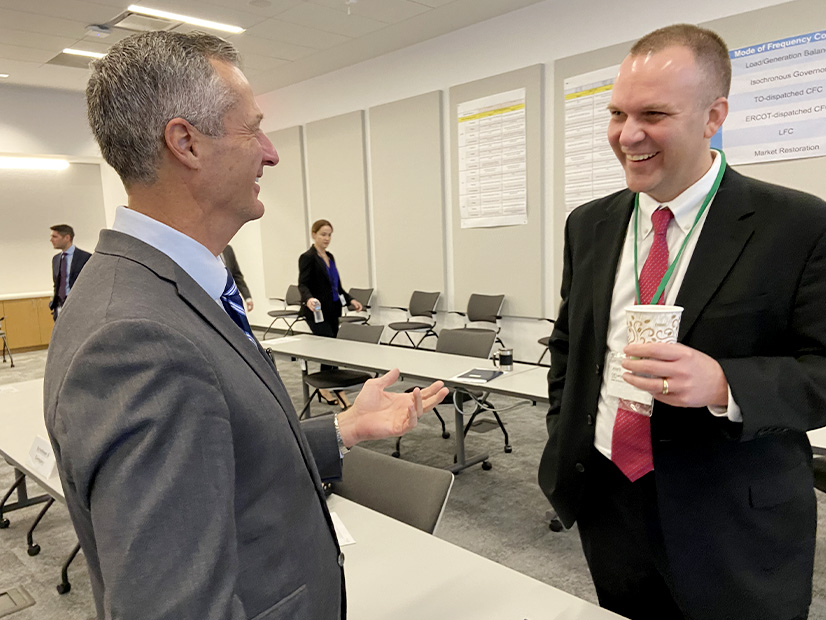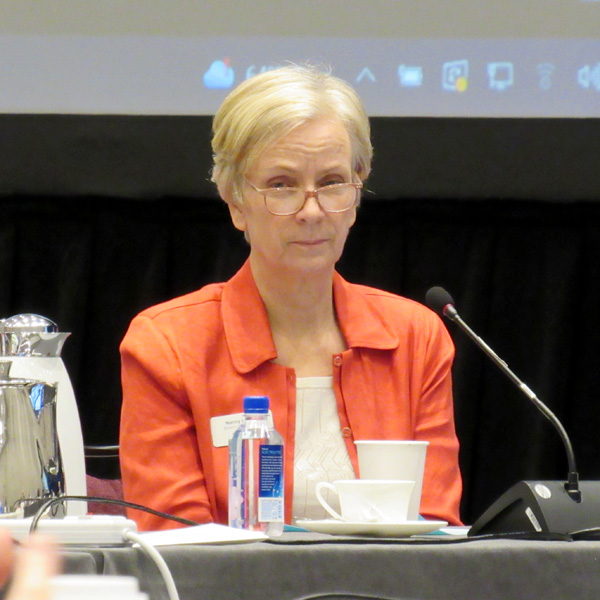New Leadership Begins to Assert its Influence
TAYLOR, Texas — Meeting publicly for the first time with almost a full complement, ERCOT’s new Board of Directors made a point to reassure any Texans listening to the webcast that a new sheriff is in town following last February’s devastating winter storm.
“This is a work in progress,” Director Carlos Aguilar said. “We’re doing everything we can to stay abreast of the situation and ensure the system remains stable.”
Fellow Director John Swainson, who has more than 40 years of technology experience, said during a quick round of introductory statements that he hopes to leverage his IT background for the grid’s benefit.
“I want to focus on how we can look 10 years into the future and even longer,” he said. “How can we get past the current set of issues, but continue to provide this same abundance of reliable energy for decades to come?”
The storm resulted in the resignation of much of the previous board, most of whom Texas’ political leadership faulted for living out of state. Following new state legislation, they have since been replaced by six independent directors, two short of a full slate, who all live in the Lone Star State. (See 2 More Directors Appointed to ERCOT Board.)
“Look at those pictures,” interim CEO Brad Jones said, pointing to a screen with images of the board’s four newest members. “It’s great to have a nearly full board.”
Interim CEO Brad Jones (left) shares a light moment with TAC Chair Clif Lange. | © RTO Insider LLC
“I can’t tell you how happy I am to see you today,” Public Utility Commissioner Will McAdams said. “You have a big job in front of you. Winter is upon us, and this organization has made giant strides to ensure we’re ready. This grid is resilient and hardened and will survive [another winter weather event]. The public remains safe.”
Jones stressed the amount of work ERCOT staff have undertaken since the storm. The legal department has been swamped with litigation issues; a new 12-person department has been created to handle winter readiness inspections as a result of new legislation; and staff are working to improve communications within the industry and not just within ERCOT.
The workload has resulted in above-normal turnover for ERCOT, but fears have lessened that the light at the end of the tunnel is another oncoming train. Jones said staff are already closely monitoring a storm due to hit Texas near the end of December.
“We’ll be ready because we’re working with the PUC,” he said. “Tweaks that will have significant value to the market, we’re making today. We’re in the same room together.”
Response to NERC-FERC Winter Storm Inquiry
Staff told the directors they have begun or completed work on nearly all of the recommendations applicable to ERCOT identified in NERC and FERC’s joint inquiry into the storm. That doesn’t include the numerous recommendations made by staff, stakeholders, regulators and legislators since February.
The federal agencies released their report in November, highlighting the failure of electric and gas utilities to adequately prepare for the storm’s extremely low temperatures. The event caused more than 23 GW of manual firm load shed as generators and their supply lines froze. (See FERC, NERC Release Final Texas Storm Report.)
Compiled by a team of more than 50 subject matter experts, the report listed 28 recommendations that covered the electric and gas industries and went beyond NERC reliability standards revisions to address cold weather, which were approved in August 2021.
Jones reassured board Vice Chair Bill Flores and the webcast’s viewers that the problems were regional and not isolated to ERCOT. Among several recommended improvements to ERCOT’s grid are improving interconnections with other grid operators beyond the current 820 MW worth of DC ties.
The report’s authors “recognized the ability to move power all the way east to Texas would have been very limited,” Jones said. “Our power supplies were cut because we have an agreement with the regions around us that if one of us gets into trouble, we can terminate the power supplies [we’re exporting]. We recognize that was an appropriate action to take.”
Betty Day, ERCOT’s vice president of security and compliance, said the grid operator is finalizing its own report on the storm and will publicly post the document when it’s complete.
“This is standard after any grid event,” she told the board.
ERCOT to Correct Prices
The directors signed off on staff’s request to correct prices for eight operating days in September and October stemming from a modeling error for a generation transmission constraint in the day-ahead market. Resettling the error resulted in more than $816,000 in increased charges and more than $122,000 in reduced charges to market participants. (See “Staff to Seek Price Correction,” ERCOT Technical Advisory Committee Briefs: Nov. 29, 2021.)
Price corrections “are largely event-based and don’t have a consistent cadence,” Dave Maggio, ERCOT’s director of market design and analytics, said when questioned about the frequency of price corrections. “There have been a handful or so of various events that have occurred.”
The grid operator’s staff must seek board approval of price corrections when they are identified outside of a short multiday deadline to make corrections themselves.
TAC’s 2022 Membership Approved
The board unanimously confirmed the 2022 Technical Advisory Committee, which will continue in its present form and with its familiar members as elected by their market sectors. The board has not yet decided whether to make any changes to the committee’s stakeholder membership. (See ERCOT Technical Advisory Committee Briefs: Nov. 29, 2021.)
PUC Chair Peter Lake welcomed the committee’s membership and offered a reminder that “with this new board, this new leadership will continue to leverage the expertise of TAC while also optimizing its effectiveness.”
“We look forward to working with you during this transition as you see fit,” said TAC Chair Clif Lange, of South Texas Electric Cooperative.
Lange will continue in the chairman’s role, and Just Energy’s Eric Blakey will remain as vice chair. The committee is responsible for recommending protocol changes and endorsing other operational issues to the board and is assisted by four sub-committees.
Board Approves $1.28B Tx Project
The directors approved a number of staff and stakeholder recommendations during the meeting, including a $1.28 billion transmission project in the Rio Grande Valley. The project would add 351 miles of transmission lines radiating from a new substation in the Lower Rio Grande Valley, which ERCOT and the PUC have both identified as in urgent need of more transmission capacity. (See “TAC Endorses $1.28B Tx Project,” ERCOT Technical Advisory Committee Briefs: Nov. 29, 2021.)
Director Aguilar asked whether the project would be eligible for funding under the federal infrastructure bill signed into law last month, saying, “Should we identify more of these that are essential and could be implemented sooner than later because of the infrastructure bill?” (See Biden Signs $1.2 Trillion Infrastructure Bill.)
“Our function is to identify the needs in the system and hand that process over the transmission provider who will do that development,” Jones said.
The board passed several other items, including:
-
-
-
- ERCOT’s proposed 2022 ancillary service methodology;
- acceptance of Schellman & Co.’s 2021 System and Organization Control Audit report;
- a litigation matter and three other items from its Thursday executive session;
- the 2022 key performance indicators; and
- ratification of several actions taken by the prior board during its remote meetings.
-
-
Directors Zin Smati and Bob Flexon abstained from the last vote.
The consent agenda, which cleared unanimously, included seven nodal protocol revision requests (NPRRs); a Nodal Operating Guide revision (NOGRR), an other binding document changes (OBDRR), a revision to the Planning Guide (PGRR) and a modification to the resource registration glossary (RRGRRs):
-
-
-
- NPRR1077: expands NPRR1026’s self-limiting facility concept to include sites with one or more settlement-only generator (SOG) and introduces additional revisions to fully address requirements for generators and energy storage systems (ESSs) connected at distribution voltage. The NPRR requires the SOG’s qualified scheduling entity to provide telemetry of the injection or withdrawal at the point-of-interconnection (POI) for transmission-connected sites or point-of-common coupling for distribution-connected sites.
- NPRR1091: addresses energy-price suppression and liquidity issues created by ERCOT’s early and greater procurement of ancillary service by extending the treatment of must-take energy from reliability unit commitments in pricing runs to offline non-spinning reserves, when it is manually deployed. The change also increases the amount of responsive reserves and non-spin services that an entity can self-arrange above its obligation.
- NPRR1094: allows a transmission operator (TOP) and transmission/distribution service providers (TDSPs) to manually shed load connected to under-frequency relays during a Level 3 energy emergency alert (EEA) if the affected TOP can meet its overall under-frequency load shed (UFLS) requirement and its load shed obligation under the Nodal Operating Guide.
- NPRR1101: modifies load resources’ deployment grouping requirements if they’re not controllable load resources providing non-spin to include generation resources providing offline non-spin.
- NPRR1103: establishes the processes for assessing and collecting default charges and default charge escrow deposits for the debt-obligation order securitizing about $800 million owed to the market by cooperatives and municipalities.
- NPRR1104: corrects the definition of real-time liability extrapolated (RTLE) to include market activity for entities that have no load or generation but do have real-time exposure.
- NPRR1107: adds new fees for ERCOT’s weatherization inspections of the resource entity’s capacity divided by the entity’s aggregate capacity.
- NOGRR233: allows a TOP and a TDSP to manually shed load connected to under-frequency relays during a Level 3 EEA if the affected TOP can meet its overall UFLS requirement and load-shed obligation.
- OBDRR035: aligns the non-spinning reserve deployment and recall procedure with NPRR1101’s revisions.
- PGRR092: allows an interconnecting entity (IE) proposing a SOG to designate it as part of a self-limiting facility during the generator interconnection or modification (GIM) process, consistent with NPRR107.
- RRGRR029: allows an IE proposing a SOG to designate it as part of a self-limiting facility during the GIM process.
-
-
The directors separately approved five non-unanimous revision requests recommended by the TAC:
-
-
-
- NPRR1106: codifies the grid operator’s current practice of deploying emergency response service when physical responsive capability falls below 3 GW before declaring an EEA.
- NPRR1109: allows a resource entity to bring a decommissioned generating unit back to service if it notifies ERCOT within three years of its removal from the network operations model.
- NOGRR236: allows ERCOT to instruct TDSPs to deploy any available distribution voltage-reduction measures before declaring an EEA.
- NOGRR237: aligns the Nodal Operating Guide with NPRR1106’s protocol changes.
- OBDRR036: revises the ERS procurement methodology document to mesh with NPRR1106.
-
-





